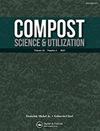Performance of the Kraft Mill Biosolids Compost and Their Quality Evaluation
IF 0.9
4区 农林科学
Q3 ECOLOGY
引用次数: 0
Abstract
Abstract The goal of this article is the evaluation of the compost quality from Kraft mill organic matter by germination Raphanus sativus and Lepidium sativum. The evaluation of compost was measured in terms of stability, maturity and phytotoxicity. Two compost piles were elaborated, one with a ratio of C/N = 23.67 and the other with C/N = 18.67. Each pile was divided into 2 sections, pile 1 (compost 1 and 2) and pile 2 (compost 3 and 4). Wood bark was added to each pile as a structuring material, resulting in mixtures conformed by treatment sludge with bark. The results obtained show that all the mixtures reached thermophilic temperatures (>50 °C), resulting in stable and mature compost with humic and fulvic acid ratios > 1.9. The gemination index showed no presence of toxic substances, with germination percentages over 80% for all the tests of Raphanus sativus and Lepidium sativum, while the N:P:K ratio of 0.5 of Compost 4 positively and significantly boosted the growth of both species with respect to control. It was concluded that Compost 4, with C/N ratio = 23.67 with structuring material presented positive and significant results (p > 0.05) with respect to Compost 1, 2 and 3.卡夫磨生物固体堆肥的性能及质量评价
摘要本文的目的是通过发芽的萝卜和蛇床子对卡夫厂有机物堆肥的质量进行评价。对堆肥的稳定性、成熟度和植物毒性进行了评估。制作了两个堆肥堆,其中一个堆肥堆的C/N比为 = 23.67,另一个带有C/N = 18.67.每一堆被分成2个部分,堆1(堆肥1和2)和堆2(堆肥3和4)。将树皮作为结构材料添加到每个桩中,通过处理污泥与树皮形成混合物。结果表明,所有混合物都达到了高温(>50 °C),形成稳定成熟的堆肥,腐殖酸和黄腐酸的比例>1.9。双生子指数显示不存在有毒物质,Raphanus sativus和Lepidium sativum的所有试验的发芽率都超过80%,而堆肥4的N:P:K比例为0.5,相对于对照,这两个物种的生长都得到了积极和显著的促进。结果表明,采用结构材料的C/N比=23.67的堆肥4表现出积极而显著的结果(p > 0.05)。
本文章由计算机程序翻译,如有差异,请以英文原文为准。
求助全文
约1分钟内获得全文
求助全文
来源期刊

Compost Science & Utilization
农林科学-生态学
CiteScore
4.10
自引率
0.00%
发文量
0
审稿时长
>36 weeks
期刊介绍:
4 issues per year
Compost Science & Utilization is currently abstracted/indexed in: CABI Agriculture & Environment Abstracts, CSA Biotechnology and Environmental Engineering Abstracts, EBSCOhost Abstracts, Elsevier Compendex and GEOBASE Abstracts, PubMed, ProQuest Science Abstracts, and Thomson Reuters Biological Abstracts and Science Citation Index
 求助内容:
求助内容: 应助结果提醒方式:
应助结果提醒方式:


